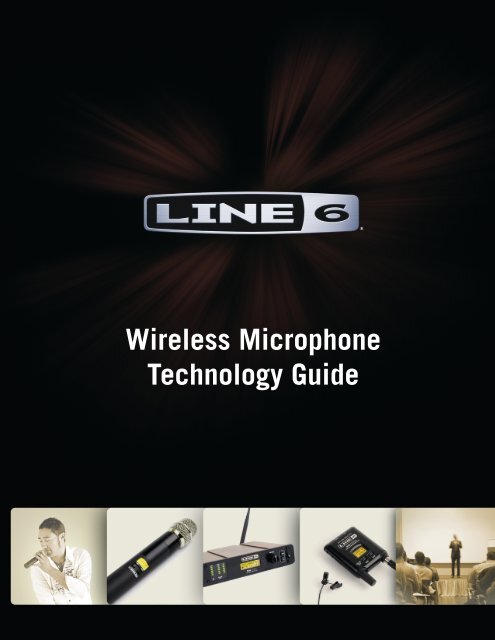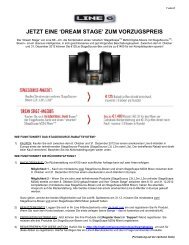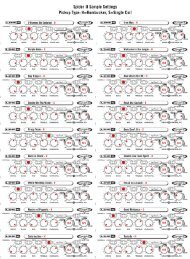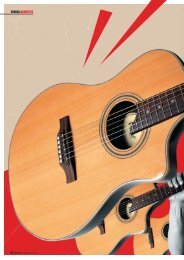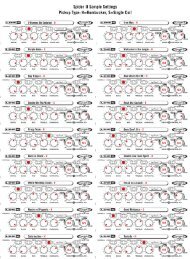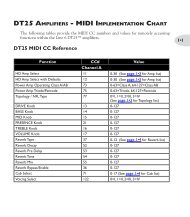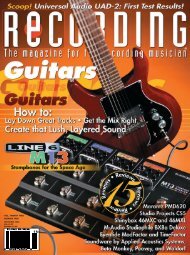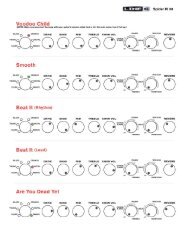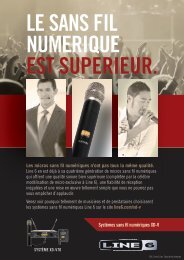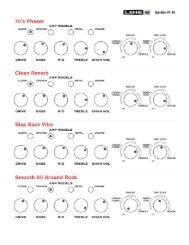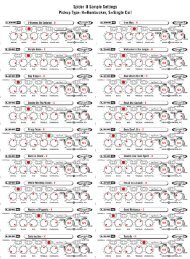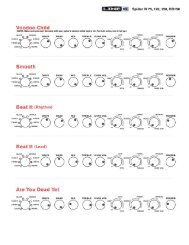Wireless Microphone Technology Guide Whitepaper - Line 6
Wireless Microphone Technology Guide Whitepaper - Line 6
Wireless Microphone Technology Guide Whitepaper - Line 6
Create successful ePaper yourself
Turn your PDF publications into a flip-book with our unique Google optimized e-Paper software.
<strong>Wireless</strong> <strong>Microphone</strong><br />
<strong>Technology</strong> <strong>Guide</strong>
What’s Inside<br />
Introduction ....................................................................................................................................................... 4<br />
The Basics ......................................................................................................................................................... 5<br />
What is RF? ................................................................................................................................................... 5<br />
RF Transmission ............................................................................................................................................ 5<br />
RF Reception ................................................................................................................................................. 5<br />
Radio Operation ................................................................................................................................................. 5<br />
Choosing a Frequency .................................................................................................................................. 5<br />
Radio Interference ......................................................................................................................................... 7<br />
Radio Distance .............................................................................................................................................. 8<br />
Diversity ......................................................................................................................................................... 8<br />
Choosing a Channel ...................................................................................................................................... 9<br />
Audio Transmission ......................................................................................................................................... 9<br />
Dynamic Range ............................................................................................................................................. 9<br />
Distortion ......................................................................................................................................................11<br />
Frequency Response ...................................................................................................................................11<br />
Summary ......................................................................................................................................................... 11<br />
Digital Benefits ..............................................................................................................................................11<br />
<strong>Line</strong> 6, Inc. | <strong>Wireless</strong> <strong>Microphone</strong> <strong>Technology</strong> <strong>Guide</strong> 3
Introduction<br />
<strong>Wireless</strong> microphones provide singers, performers, and presenters with<br />
the freedom of mobility unconstrained by cables. But this benefit has<br />
historically been provided at the cost of compromised audio quality, radio<br />
interference artifacts, and setup complexity. For over fifty years analog<br />
FM radio technology has been the dominant approach utilized for wireless<br />
microphones, but now digital wireless promises to usher in an era of<br />
uncompromised, problem-free performance.<br />
This paper’s goal is to provide a technical background of both traditional<br />
analog wireless and digital wireless technology, and to provide insight into<br />
the differences between them.<br />
Figure 1 Radio waves range from 3 kHz to 300GHz in the Electromagnetic Spectrum.<br />
Professional wireless microphones operate in the UHF range of radio waves.<br />
4<br />
<strong>Line</strong> 6, Inc. | <strong>Wireless</strong> <strong>Microphone</strong> <strong>Technology</strong> <strong>Guide</strong>
The Basics<br />
What is RF?<br />
RF is an abbreviation for “Radio Frequency” and<br />
is used to describe the range of spectrum utilized<br />
for many types off wireless transmissions, including radio,<br />
television, mobile phones, remote controls, and wireless<br />
microphones. The term “Radio” in its most basic<br />
definition is the transmission of electromagnetic waves<br />
through space. These electromagnetic waves can vary<br />
in length and amplitude and occur naturally all around<br />
us. The wavelength is the physical distance between<br />
the start of one cycle and the start off the next cycle as<br />
the wave moves through space. The rate of the wave is<br />
measured in Hertz (abbreviated Hz), or cycles per second.<br />
This is called the “Frequency” of the electromagnetic<br />
wave. Figure 1 shows a basic guide of electromagnetic<br />
waves and their respective frequencies, with radio waves<br />
broken out into the lower part of the figure.<br />
RF Transmission<br />
Radio waves can be used as a method for<br />
transmitting information. The most common method<br />
used for transmitting analog audio via RF is with<br />
Frequency Modulation, or FM. The radio frequency<br />
being transmitted is called a carrier wave. This carrier’s<br />
frequency is modulated up and down depending on the<br />
amplitude of the audio. This technique is used in FM<br />
broadcast radio, and in analog wireless microphones.<br />
Figure 2 gives a visual representation of a carrier wave<br />
modulated by an audio wave.<br />
Figure 2 FM of a radio wave by an audio signal<br />
(proportions scaled for graphic clarity<br />
For the transmission of digital audio, a number of<br />
different techniques exist, but they share in the principle<br />
that the carrier’s frequency (and sometimes phase) is<br />
altered based on the data to be transmitted. A common<br />
example of transmitting digital signal (“ones”” and<br />
“zeroes”) is a form of frequency modulation called<br />
Frequency Shift Keying (FSK). The frequency of the<br />
carrier is shifted to represent a bit of data, as shown in<br />
Figure 3.<br />
Figure 3 FSK of a radio wave by a data signal<br />
Additional types of modulation of frequency and<br />
phase of a carrier can enable several bits of data to be<br />
transmitted within one portion of the carrier, allowing for<br />
more efficient transfer of data over the air.<br />
RF Reception<br />
In order to recover the audio or data signal from the<br />
carrier, the receiver needs to demodulate the frequency<br />
modulation of the carrier. A number of different techniques<br />
exist for performing this function. The details of this<br />
process will not be covered in this paper, but can be explored<br />
further in other RF technology literature if desired.<br />
Radio Operation<br />
Choosing a Frequency<br />
In the US, radio frequency usage is governed by the<br />
Federal Communications Commission. Similar agencies<br />
regulate communications in most other countries.<br />
The FCC designates what frequencies can be used<br />
by whom, as well as how much power (in Watts) can be<br />
broadcast.<br />
Television is broadcast using radio waves with typically<br />
hundreds of thousands of Watts of power.<br />
<strong>Wireless</strong> microphones, WiFi hubs, and other portable<br />
wireless devices typically transmit with less than one Watt<br />
of power.<br />
In the UHF radio spectrum, the allocation of frequencies<br />
is shown in the following table:<br />
<strong>Line</strong> 6, Inc. | <strong>Wireless</strong> <strong>Microphone</strong> <strong>Technology</strong> <strong>Guide</strong> 5
UHF analog wireless microphones typically operate<br />
in the broadcast TV range designated as channels 14<br />
through 51 (in the USA). Many devices also exist that<br />
operate in the band that previously occupied TV channels<br />
52 through 69 (also known as the “700MHz band”), but as<br />
of 2009 these frequencies were auctioned for commercial<br />
use and public safety, and can no longer be used<br />
for wireless microphones.<br />
Some analog wireless systems have been designed to<br />
operate in either of the two ISM bands (named for their<br />
general usage in Industrial, Scientific, and Medical<br />
applications, although not limited to these areas).<br />
However, for analog wireless to operate with minimal<br />
problems, it needs to occupy an unused frequency band.<br />
This makes the ISM bands problematic, since other<br />
usage might interfere with their operation. (This is not a<br />
problem for digital data, which will be described later.)<br />
The TV bands are used for digital broadcast<br />
television, which can overwhelm the power of a wireless<br />
microphone’s signal. But since not every broadcast<br />
channel is currently used in every city, there are<br />
potentially open areas available, commonly referred to as<br />
“white spaces”. This term comes from the “white” screen<br />
of “snow” (noise) that would appear on a TV if it was<br />
tuned to an unused channel.<br />
For a wireless microphone to function in the TV bands,<br />
a white space frequency must be selected. This varies<br />
from city to city, depending on which TV channels are<br />
in use. For example, here are the channels used in Los<br />
Angeles:<br />
6<br />
<strong>Line</strong> 6, Inc. | <strong>Wireless</strong> <strong>Microphone</strong> <strong>Technology</strong> <strong>Guide</strong><br />
This leaves the following channels and frequency<br />
ranges currently available:<br />
According to FCC records however, all of these<br />
remaining channels have applications pending for new<br />
TV stations.<br />
Typical analog wireless systems have selectable<br />
channels, but cover only a part of the UHF range (usually<br />
from 18MHz to 60MHz wide). Each city has its own UHF<br />
channel usage assignment, so it is important to be<br />
familiar with what channels are available prior to<br />
purchasing an analog wireless system to be sure its<br />
range is assignable to an unused TV channel. For<br />
example, a wireless system with a tunable range of<br />
572MHz to 590MHz (channels 31 through 33) would<br />
not be suitable for use in Los Angeles.
Until now, the FCC has always required a license to<br />
use wireless microphones within any of the UHF TV<br />
channels, as described in Part 74 Subpart H of Title 47<br />
of the Code of Federal Regulations.<br />
For the time being the FCC is allowing wireless<br />
microphones to be used without a license under part<br />
15 rules that restrict power levels and require them<br />
not to interfere with licensed users as well as accept<br />
interference from those licensed users of the band.<br />
The rules are expected to be revised after June 2010.<br />
Beginning in 2010, new TV Band Devices (TVBDs,<br />
previously called White Space Devices,, or WSDs) are<br />
expected to enter the market and take advantage of a<br />
recent FCC ruling allowing unlicensed use of white space<br />
spectrum not assigned to TV broadcast in that area. It is<br />
expected that TVBDs will provide services like extended<br />
WiFi and in-home wireless video. These devices are<br />
required to monitor the radio waves once per minute to<br />
detect if a wireless microphone is present and to avoid<br />
that frequency if detected, although it is not yet clear how<br />
effective this technique will be in limiting interference with<br />
analog wireless microphones.<br />
<strong>Line</strong> 6 digital wireless microphone systems operate<br />
in ISM bands. These bands do not require a license,<br />
and are free from high powered interference such as<br />
broadcast TV.<br />
As a result they are also free of geographical<br />
restrictions and can operate on all channels worldwide<br />
without the need to determine what commercial<br />
broadcast TV channels are operating nearby.<br />
They do, however, have to coexist with other users<br />
of these bands. In the 900MMHz range, this typically<br />
includes some cordless telephones and other low power<br />
remote applications. The 2.4GHz range also includes<br />
WiFi and Bluetooth communication. But since all of these<br />
devices are transmitting data as opposed to analog<br />
audio, the spectrum can be effectively shared with<br />
multiple devices. Unlike analog transmission, digital<br />
data is coded for the specific recipient of that data and<br />
all other data is ignored. This also applies to WiFi<br />
communication, which can support dozens of computers<br />
all in the same room without worry that one will receive<br />
information intended for another.<br />
Radio Interference<br />
Anyone familiar with a traditional FM radio has<br />
experienced many types of interference artifacts. When<br />
two radio stations are close together in frequency, it is<br />
sometimes possible to hear a combination of both at<br />
the same time. Or when manually tuning a radio to a<br />
frequency that is not broadcasting, noise can be heard<br />
as a result of the spurious electromagnetic waves that<br />
are always around us.<br />
In analog wireless microphones, any interference<br />
that causes audio artifacts can disrupt a performance.<br />
Causes of interference include obstructions (people,<br />
walls, equipment), radio wave reflections (causing multiple<br />
paths of the signal to be received), and TV channels.<br />
Any interference that alters the reception off the audio<br />
modulation of the carrier can produce unwanted audio<br />
artifacts. One way that analog wireless attempts to<br />
reduce spurious radio waves from being turned into<br />
audio is the use off a pilot tone and a squelch circuit.<br />
The squelch circuit’s main purpose is to mute<br />
(“squelch”) the audio output when the transmitter’s<br />
signal is not being received. Without this, the receiver<br />
would output high amplitude noise due to the random<br />
radio waves it is receiving. But when the transmitter<br />
signal is being received, the system needs some method<br />
to attempt to differentiate the wanted signal from any<br />
interfering signal. One method is to have the transmitter<br />
always transmit a pilot tone along with the audio. This<br />
tone is usually at a very high audio frequency, and is<br />
filtered out before the audio is output from the receiver.<br />
If the receiver does not see the pilot tone at the expected<br />
level, then the squelch circuit is turned on to mute the<br />
audio. Since modulated tones can be created due to<br />
interference, spurious audio is still able to pass through<br />
the system in certain circumstances.<br />
Digital wireless microphones, like all digital<br />
transmission systems, rely on data being “correct”,<br />
that is, a zero is always a zero, and a one is always a<br />
one. However, noise or interference on the signal will<br />
not have an impact on the receiver’s interpretation of<br />
the data unless it is significant enough to make the data<br />
unreadable.<br />
When an analog audio signal has noise or<br />
interference, the result becomes audible because<br />
it is combined with the intended audio waveform,<br />
as shown here:<br />
<strong>Line</strong> 6, Inc. | <strong>Wireless</strong> <strong>Microphone</strong> <strong>Technology</strong> <strong>Guide</strong> 7
When a digital signal has noise or interference<br />
up to a certain level, the data can still be properly<br />
interpreted as ones and zeroes without any alteration<br />
in the audio, as shown in the next diagram:<br />
The low and high signals (zeroes and ones) can still be<br />
read without any audible artifacts.<br />
Significant radio interference can impact a digital<br />
receiver’s ability to correctly interpret the zeroes<br />
and ones. But digital has the advantage of being able to<br />
include additional information to help the receiver know<br />
if the data is correct. This is called error detection, and is<br />
commonly used in most digital storage or communication<br />
systems. This is usually performed by adding additional<br />
data to each packet of information that can be<br />
mathematically checked to validate the whole packet<br />
of data as being good or bad.<br />
For a simple example, if the numbers 3 and 5 were to<br />
be transmitted, and along with them their sum (8) was<br />
also transmitted, the receiver could check that the two<br />
numbers received add up to the third number to be sure<br />
that the data was received correctly. If the numbers don’t<br />
add up, then error correction or concealment can be<br />
deployed (these techniques won’t be discussed here,<br />
but use additional transmitted data to reconstruct any<br />
data that is lost).<br />
These types of techniques are used on CDs and DVDs,<br />
and explain why a disk can have a significant scratch and<br />
still be playable without errors. Additionally, digital systems<br />
can encode their data so that other digital signals in the<br />
same band cannot be misinterpreted as the intended data.<br />
The only data that will be read is the data intended for that<br />
receiver.<br />
Radio Distance<br />
The further away a transmitter is from its receiver, the<br />
lower in level the transmitter’s signal is to the receiver.<br />
As distance increases, the signal to noise ratio of the<br />
radio waveform gets worse.<br />
In analog wireless systems, this weakened signal can<br />
result in increased audio noise coming out of the receiver<br />
since the radio quality directly impacts the audio quality.<br />
8<br />
In digital wireless systems, the audio quality remains<br />
constant throughout the distance range, since the level<br />
of noise on the digital signal does not affect the analog<br />
audio signal.<br />
Diversity<br />
<strong>Line</strong> 6, Inc. | <strong>Wireless</strong> <strong>Microphone</strong> <strong>Technology</strong> <strong>Guide</strong><br />
The term “true diversity” is often used too describe<br />
a feature of many analog wireless systems that utilize<br />
two antennas and two receiver circuits. Since the two<br />
antennas are spaced apart, they pick up the RF signal<br />
relative to their respective location. When the signal at<br />
one antenna is weak (due to an obstruction or multipath<br />
interference), the signal at the other antenna may not be<br />
as affected. These wireless systems have circuitry that<br />
selects the audio signal from the receiver that has the<br />
stronger signal. Switching noise is encountered,<br />
but is usually low enough to not be disruptive.<br />
Digital systems use a similar approach to this type<br />
of diversity (also known as “spatial” diversity). Two<br />
antennas and two receiver circuits are used, but instead<br />
of switching the audio, the digital data from both receivers<br />
is compared and the one with the fewest errors detected<br />
is used. Since the data is received and buffered on both<br />
receivers, the decision of which data to use can happen<br />
continuously and without any interruption of audio from<br />
the switchover.<br />
An additional diversity that <strong>Line</strong> 6 Digital <strong>Wireless</strong><br />
systems provide is Frequency Diversity. Frequency<br />
diversity utilizes multiple RF carrier frequencies to carry<br />
different parts of the audio data. This significantly reduces<br />
the impact of other RF signals, since the interference is<br />
not likely to be present on all of the frequencies being<br />
used.<br />
The result of the error detection, frequency diversity,<br />
and data coding properties of digital wireless allow<br />
<strong>Line</strong> 6 2.4 GHz wireless systems to operate in heavily<br />
congested RF environments without the necessity of a
clear channel while ensuring that the only audio that<br />
will ever be passed through the receiver is the intended<br />
audio from the transmitter.<br />
Choosing a Channel<br />
In many analog wireless systems, each uniquely<br />
selectable frequency is called a “channel”. This<br />
terminology can be misleading, since most of these<br />
channels typically cannot be used at the same time.<br />
Analog wireless frequencies need to be spaced apart,<br />
typically by at least 1MHz, in order for them to operate<br />
with minimal interference. But selectable channel<br />
frequencies on many devices can be spaced as close<br />
as 25kHz from each other. Fine resolution of tuning<br />
is provided in order to make it more likely to find<br />
frequencies that have minimal interference. Due to<br />
the space needed between simultaneously operating<br />
channels, the number of actual usable channels is<br />
about ten times less than the number of frequencies<br />
that are selectable.<br />
Most analog wireless companies provide software or<br />
web-based tools to help the user select an appropriate<br />
frequency. Since most affordable devices do not display<br />
the TV channel or frequency in MHz, it is necessary to<br />
refer to these tools in order to know which group and<br />
channel is an appropriate choice for the area. Some<br />
models provide a scan function that will select a<br />
frequency that is available for wireless use. This can also<br />
help in selecting a channel, presuming that the device’s<br />
frequency range extends into areas not occupied by local<br />
TV stations.<br />
Additionally, channel selection needs to be considered<br />
any time the device is to be used in a different city, due<br />
to the variations in TV channel usage throughout the<br />
country.<br />
In digital wireless systems operating in the ISM bands,<br />
all channels are always available. This is because there<br />
are no competing high powered transmitters permitted in<br />
this space. The total number of channels selectable is the<br />
number of channels that can be used simultaneously.<br />
Additionally, ISM bands are usable throughout the world<br />
regardless of the local TV channel assignments.<br />
Audio Transmission<br />
Due to FCC regulatory bandwidth limitations, analog<br />
FM has a less than ideal dynamic range and frequency<br />
response for transmitting audio signals. These inadequacies<br />
require analog FM wireless microphones to perform<br />
signal processing on both the transmitter and receiver.<br />
Dynamic Range<br />
Dynamic range is defined as the loudness difference (in<br />
decibels, or dB) between the softest and loudest signals<br />
possible in a system.<br />
The typical dynamic range of an unprocessed audio<br />
signal transmitted via FM is about 50dB. This is because<br />
the audio dynamic range is directly proportional to the<br />
amount of frequency modulation that can be applied to<br />
the carrier, and the amount of modulation is limited so it<br />
won’t overlap into adjacent frequency bands.<br />
In order to achieve 100dB of dynamic range, which<br />
is considered to be a minimum for high quality audio,<br />
an analog wireless microphone compresses 100dB of<br />
input dynamic range by a ratio of 2:1 in order to have it<br />
fit within 50dB. This compression is achieved by using<br />
a “VGA”, or Variable Gain Amplifier, with its gain being<br />
adjusted as a function of the average signal level being<br />
input. Louder signals are reduced in level, and/or softer<br />
signals are increased in level, so that the overall dynamic<br />
range is smaller.<br />
On the receiver side, expansion is required, again using<br />
a VGA, in order to attempt to restore the original dynamic<br />
range. In this case, louder signals are made louder, and<br />
or softer signals are made softer, such that the original<br />
dynamic range is restored. The combination of these two<br />
processes is known as “companding” (a combination of<br />
compressing and expanding).<br />
Unfortunately, companding does create some sonic<br />
artifacts. Depending on the time constants used to<br />
analyze the signal level and “decide” on the gain the<br />
VGA is set to, gain changes can become audible,<br />
creating a sound often called “breathing”. This can be<br />
heard most obviously when a loud transient sound<br />
occurs, causing the VGA gain to quickly reduce level to<br />
compress the signal. After the transient has passed, the<br />
VGA gain is gradually returned to “normal”, during which<br />
time any other sound or noise can be heard to increase<br />
in volume, or breathe. Additionally, the expander on the<br />
receiver has no knowledge of the original input signal,<br />
so its ability to restore the original dynamic range is<br />
dependent on the manufacturer’s accuracy of matching<br />
the time constants and gain control between the<br />
transmitter and receiver.<br />
<strong>Line</strong> 6, Inc. | <strong>Wireless</strong> <strong>Microphone</strong> <strong>Technology</strong> <strong>Guide</strong> 9
Additionally, the dynamic range of the original audio<br />
signal can exceed 100dB. In order to accommodate this,<br />
the transmitter usually has a user adjustment for level<br />
control. If a singer is clipping the input, then the<br />
transmitter’s signal level must be adjusted downward,<br />
and the receiver’s level must be proportionally adjusted<br />
upward to maintain unity gain. Typical FM transmitters will<br />
also include an additional audio processing section called<br />
a “limiter”. This function prevents an overload condition<br />
of the audio signal which can cause distortion. The limiter<br />
also prevents “overmodulation” (excessive frequency<br />
deviation) of the RF signal. Overmodulation results in<br />
the RF signal deviation exceeding the bandwidth of the<br />
receiver, resulting in additional distortion. The limiter<br />
prevents the audio signal from exceeding a preset<br />
maximum level.<br />
Dynamic range in analog systems is further reduced in<br />
high frequencies due to a technique called Pre-emphasis/<br />
De-emphasis. Pre-emphasis is the act of boosting high<br />
frequencies in the audio band and De-emphasis is the<br />
act of cutting high frequencies in the audio band. These<br />
methods are used to improve signal to noise during<br />
transmission. The boosted high frequencies produce a<br />
larger deviation of the RF carrier thus creating a larger<br />
signal compared to the existing RF noise floor. Once the<br />
signal is received, the De-emphasis reduces the high<br />
frequencies, also reducing noise in the process.<br />
10<br />
The result is a reduction in the residual noise present in<br />
analog FM wireless systems, but at the cost of reduced<br />
dynamic range in higher frequencies due to the higher<br />
gain of these frequencies at the transmitter.<br />
Digital wireless systems are able to transmit the digital<br />
audio signal without any compression or limiting, or<br />
Pre-emphasis/De-emphasis. It also can accommodate a<br />
wider input dynamic range, eliminating the need for level<br />
controls. The result is that the input signal is accurately<br />
reproduced at the receiving end.<br />
Distortion<br />
<strong>Line</strong> 6, Inc. | <strong>Wireless</strong> <strong>Microphone</strong> <strong>Technology</strong> <strong>Guide</strong><br />
The term Distortion is used to describe any<br />
nonlinearity in a system, which can result in altering<br />
the intended sound. The nature of companders introduce<br />
a nonlinearity that results in an increased level of<br />
distortion. Additionally, high level signals can cause<br />
overmodulation distortion. Most analog wireless systems<br />
specify their Total Harmonic Distortion at a level in which<br />
the compander is steady and no overmodulation can<br />
occur. In these conditions, the THD specification is<br />
typically 0.1% to 0.5%.<br />
In a digital wireless system, the distortion is a<br />
function of the overall linearity of the system. There is<br />
no compander, nor any audio overmodulation possibility.<br />
The signal remains linear throughout the dynamic range,
esulting in a typical Total Harmonic Distortion<br />
specification of 0.03%, an order of magnitude<br />
improvement.<br />
Frequency Response<br />
The frequency response of an analog wireless system<br />
is limited at both the low and the high end. On the low<br />
end, it is necessary to roll off frequencies that would<br />
interfere with the companding circuitry. For example, a<br />
frequency of 20Hz is slow enough to cause the gain to<br />
change with each cycle of the waveform. Therefore, low<br />
frequencies are filtered out. The high frequencies are<br />
limited by the constraints of analog FM technology, which<br />
typically cannot produce frequencies above 15kHz. The<br />
following graph shows the wireless frequency response<br />
of two popular brands:<br />
The high frequency response of a digital wireless<br />
system is a function of the sample rate, and not any<br />
aspects of the RF transmission.<br />
Also, since there is no compander, the low<br />
frequencies do not need to be rolled off. As a result,<br />
a digital wireless system can transmit signals flat<br />
between 10Hz and 20kHz.<br />
These graphs represent the frequency response<br />
of the wireless systems, independent of the microphone<br />
element frequency response. Each microphone has its<br />
own tonal response, which can determine the character<br />
of its sound. If a wireless system has a flat frequency<br />
response, it allows the characteristics of the microphone’s<br />
response to remain unaltered.<br />
Summary<br />
<strong>Line</strong> 6’s digital technology brings a number of<br />
advantages to the world of wireless microphones.<br />
By overcoming the limitations of analog systems,<br />
wireless can now be used with all the reliability, ease,<br />
and sonic benefits of a wired microphone.<br />
Digital Benefits<br />
• Ultra-Simple set up and use<br />
• No interference from broadcast TV<br />
• No frequency coordination per location<br />
• All 2.4GHz channels work world-wide<br />
• No license required<br />
• No Pre-emphasis/De-emphasis<br />
• No companding<br />
• No limiting<br />
• No gain, pad or squelch adjustments required<br />
• >115dB dynamic range<br />
• 10Hz – 20kHz frequency response<br />
• 0.03% Total Harmonic Distortion<br />
• Audio quality unaffected by RF interference<br />
<strong>Line</strong> 6, Inc. | <strong>Wireless</strong> <strong>Microphone</strong> <strong>Technology</strong> <strong>Guide</strong> 11
Digital wireless is better. And <strong>Line</strong> 6 XD-V digital wireless<br />
microphone systems are exceptional. Each one delivers<br />
unmatched wireless performance, simplicity, and sound on<br />
every stage around the world – license free. Our 4th-generation<br />
digital technology makes sure of it. You can put your faith in<br />
ancient analog technology, or you can simply choose digital.<br />
Make the right choice at line6.com/wireless-microphone<br />
XD-V BELTPACKS<br />
XD-V30 XD-V70<br />
XD-V Digital <strong>Wireless</strong> Systems<br />
Over a decade of digital innovation


